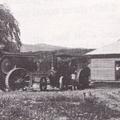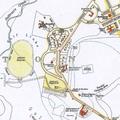< Early Canberra Government Schools
Acton school [1920 - 1923]
A small group of the new Canberra public servants at Acton submitted a petition to the Surveyor General in 1919, requesting the establishment of a school at Acton, and recommending that the Acton Recreation Hall be used during the week for the school. The Accountant at the Military College Duntroon, Mr Kilgour, let it be known that his sister Agnes was suitable experienced, and could stay with him, solving the perennial problem of finding suitable accommodation for teachers. A Provisional school opened in the recreational hall at Acton in February 1920, with Cyril Caldwell as teacher. After three months however, he was succeeded by Agnes B Kilgour - but she only stayed until the end of that year. Miriam Fitzgerald, the next teacher, also resigned after a few months, complaining that she was accommodated at the Bachelors Quarters, the only lady amongst more than forty men(!). She moved after only nine months and was replaced by Mervyn Nash.
In February 1923 the Commonwealth Surveyor General wrote to the Under-Secretary, NSW Department of Education, requesting that Nash be replaced by a more experienced teacher, and listed twenty children attending the school at that time as follows:
Alice Avery, Clara Kaye, Gordon Kaye, Jack Pollard, Pat Corkhill, Freda Cox, Margaret Rolland, Hector Hornsburgh, May Dorman, Fred Curley, Grace Curley, Fay Cox, Joan Horsburgh, Dick Brackenreg, Percy Thurbon, Bernice Ryan, Mavis Curley, Adele Mildenhall, Jack Dorman, Althea Mouat
Nash disputed the judgement on his abilities and identified errors in the list of pupils. Eventually the Inspector determined that no action was necessary. The Acton school was closed in October 1923 following the opening of Telopea Park public school, and Acton children were bussed to Telopea.
Schools and teachers 1921 - 27. from W M Rolland, Growing up in early Canberra' (Kangaroo Press, 1988):
The teacher had a shock of black hair, wore thick lensed glasses and seemed incapable of ever standing still. I took an immediate dislike to him and eyed with apprehension the cane soaking in a bucket of water. The cane was for basket work and was soaking in water to make it pliable.....Understandably, I had never imagined that school could be like this. A galvanized-iron hall with a piano on the stage at one end and a few well worn desks and backless forms scattered around the floor. The three fire buckets stood in an wooden rack beside an open fireplace in which there was a pile of ashes but no fire. I was to learn that this hall was not only school but also church for Catholics and Protestants, dance hall, venue for flower show, fire-brigade drill and any other community activity. Little wonder that the standard of education was a concern to the parents and whatever equipment they provided presented problems of storage in the multi-purpose hall.
However, there was one area where the teacher did excel and that was teaching spelling. Perhaps this was due to his delight in 'spelling bees'. The class sat in two rows facing one another.Each word was offered to one side and then to the other until the correct spelling was given and a point was scored by that side. I still remember my feeling of having let the side down when the scores were equal and I was given the word 'divide' to spell. 'D-e-v-i-d-e' I answered with confidence.........The word passed to the other side and they scored the winning point.
Gardening was a popular item on the curriculum. A few basic tools were kept under the building. Supervision was lacking when the teacher took his usual after dinner nap; no doubt to compensate for disturbed nights at the Bachelor's Quarters, where he was accommodated, along with the other unmarried public servants......
The tin-hall school was built very close to the banks of the Molongolo River. In 1922 when the river flooded and a preview of Burley Griffin's lake system was seen, the school was in danger of being floated off its stumps. It was decided to move the school up to higher ground where it would also be more accessible from the road. Two traction engines, early Canberra's beast of burden, were brought in to drag the building to its new site not far from the first Federal offices in Acton. School children began to arrive from all directions and a great cheer went upon when the water-stained building at last began to move".(pp 39-41) (see photo)
Yabbies at Acton: A history of Canberra 1913-1927. Ruth Robinson. [Author 1984, p 11]:
The first school for the children of the early civil servants was on the flat at Acton near Mr Weston's experimental nursery It was held in the hall which also doubled for meetings and social occasions. Later the Hall was moved to the road [ed - after the Molonglo flood of 1922] and eventually became the Trades and Labour Hall. The school was known as a provisional school, a tern used to describe a school of not less than ten pupils. The school had four teachers in its short life of 1920 - 23, namely Mr Caldwell, Miss Kilgour, Miss Fitzgerald and Mr Mervyn Nash. Miss Kilgour, a South Australian teacher was the sister of Mr Kilgour who lived in one of the Acton cottages and had three children at the school.
Mr Nash was the teacher I knew and I remember being frightened of him. He ruled by the cane - it reposed on his desk at all times. I did not go there was a pupil but would spend the day there sometimes with my brother if my mother had to go to the doctor or dentist"
Acton Hall when Canberra was younger. Memories of other days:
Renovations are to be considered to the Canberra Trades Hall, formerly known as Acton Hall, which has a past as colourful as any building in Canberra. Officers from the Department of Interior will inspect the Trades Hall to-day to ascertain what renovations are required. Representations were made last week by the Trades and Labour Council to have the hall re-conditioned. There is an acute shortage of public halls in Canberra and the Trades and Labour Council has received many requests for the hire of the building.
Inquiries yesterday failed to trace any "old-timer" who could remember when the hall was first built. Most were guessing but the consensus of opinion was "about 1918." Prior to 1920, the hall was the hub of the small social activity in Canberra. In the "roaring twenties," it reached its peak of popularity and always seemed a shade ahead of its rivals for popular fame—Westridge Hall and Molonglo Hall.
Today a handful of Canberra unions and organisations use it as a meeting-place. Gone are the days of the Saturday night dances which almost the entire population of Canberra attended. Gone also are the days of the Sunday church services held in a hall festooned with balloons and coloured streamers and dozens of 'empties' out the back.
Acton Hall did not always stand on its present site. Prior to 1923, it occupied a position near the present Acton stables and the blocks on which it rested may still be seen.
Pioneers still speak of the functions held there by the Canberra Cricket Club. Many a Canberra matron met her present husband there. Apart from being a social centre the hall was used as a school. Two of the teachers were Mr. Nash and Miss Fitzpatrick.
For the history of Acton see Frank Dunshea's 'recollections'; the Acton Heritage Management Plan; Ann Gugler's history of early settlement at Acton and Allen Mawer, 'Canberry Tales']
Children who attended the Acton School (1920-23):
JR (Dick) Brackenreg, May Dorman, Hector Horsburgh, Joan Horsburgh, John Kilgour, Walter Kilgour, Joan Kilgour, Jack Rolland, Margaret Rolland, Maitland Rolland, Bob Vautin, Sybil Edwards, Alice Avery, Harold O'Brien, Andrew O'Brien, Leo O'Brien, Grace Curley, Fred Curley, Mavis Curly, Freda Cox, Fay Cox, Kitty Bates, Edith Gordon, Phyllis Corkhill, Brendan Corkhill, Pat Corkhill, Clara Kaye, Gordon Kaye, Don Smith.
Children who were too young for school but went occasionally: Jack Dorman, Percy Thurbon, Eric Dunshea, Ruth Brackenreg.
Ann Gugler, Early Canberra-Canberra 1920's Scroll down to Acton Hall
Location Map
Teachers
- Caldwell, Mr Cyril
02/1920 - 04/1920 - Kilgour, Agnes
05/1920 - 12/1920 - Fitzgerald, Miriam
01/1921 - 09/1921 - Nash, Mr Mervyn R
10/1921 - 10/1923
NSW Government schools from 1848
- Acton school (external link)
< Early Canberra Government Schools
If you are able to assist our work of identifying, documenting, and celebrating the early bush schools of the Canberra region, please contact us or .




